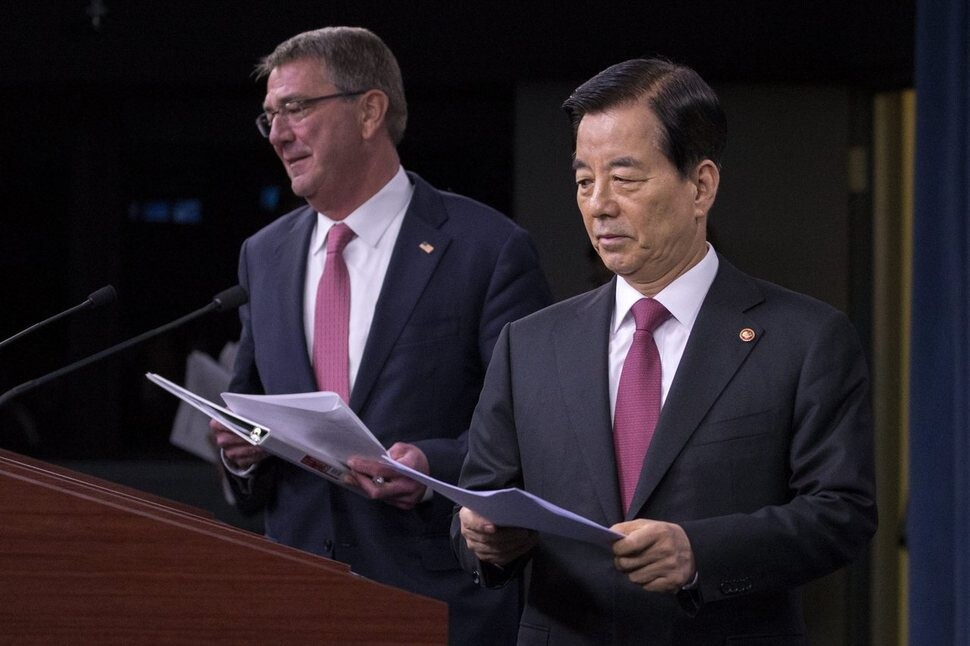hankyoreh
Links to other country sites 다른 나라 사이트 링크
S. Korea and the US don’t reach deal on permanent deployment of strategic US weapons

A plan by the South Korean government for the permanent rotational deployment of strategic US weapons on the Korean Peninsula, intended to strengthen its deterrent against the North Korean nuclear and missile programs, has been shelved.
The South Korean Minister of National Defense and US Secretary of Defense discussed the plan at their 40th Security Consultative Meeting at the Pentagon in Washington on Oct. 20, but failed to reach an agreement.
At a joint press conference with US Secretary of Defense Ashton Carter after the meeting, Defense Minister Han Min-koo said only that additional measures “such as the deployment of strategic assets permanently on the Korean Peninsula on a rotational basis” would be examined at a later date.
In their joint statement the same day, the two ministers would only say they had agreed to examine additional measures to strengthen extended deterrence with the 2+2 (Foreign and Defense Ministers’) Extended Deterrence Strategy and Consultation Group (EDSCG) framework to eliminate any doubts from Pyongyang on the alliance’s resolve.
The South Korean Ministry of National Defense began discussing the idea of rotational deployment with the US after South Korean conservatives complained that US strategic assets were not being mobilized in a timely manner in response to North Korea’s nuclear tests and missile launches. Both sides were reported as originally agreeing on the permanent deployment of strategic weapons on the peninsula on a rotational basis, which was to be reflected in their joint statement. “Strategic weapons” include long-range strategic bombers, nuclear-powered aircraft carriers, and nuclear-powered submarines, which are capable of carrying nuclear weapons and moving over long distances and possess extensive destructive force.
Han addressed the issue in a separate talk with foreign correspondents and reporters assigned to the ministry after the joint press conference.
“There is no doubt whatsoever about the US’s ability and commitment to duties in terms of supporting and defending South Korea. I have stated several times the position that they are certain even now,” he said.
“At the same time, in response to our request that this be fleshed out a bit more, the US settled on the position that we should try discussing it and examining it in more detail through the Foreign and Defense Ministry vice minister-level consultative group created this time and the South Korea-US Deterrence Strategy Committee (DSC) that we have been using,” he continued.
Han’s remarks suggest the US may have balked at South Korea’s calls for permanent rotational deployment of strategic assets.
But when asked repeatedly whether the US did send a message of delicate refusal, Han replied, “The US never made any euphemistic refusal, and it would be more appropriate to understand its message as being that it was not strategic to specify that it would or would not be doing a certain thing strategically.”
By Yi Yong-in, Washington correspondent
Please direct questions or comments to [english@hani.co.kr]

Editorial・opinion
![[Column] Park Geun-hye déjà vu in Yoon Suk-yeol [Column] Park Geun-hye déjà vu in Yoon Suk-yeol](https://flexible.img.hani.co.kr/flexible/normal/500/300/imgdb/original/2024/0424/651713945113788.jpg) [Column] Park Geun-hye déjà vu in Yoon Suk-yeol
[Column] Park Geun-hye déjà vu in Yoon Suk-yeol![[Editorial] New weight of N. Korea’s nuclear threats makes dialogue all the more urgent [Editorial] New weight of N. Korea’s nuclear threats makes dialogue all the more urgent](https://flexible.img.hani.co.kr/flexible/normal/500/300/imgdb/original/2024/0424/7317139454662664.jpg) [Editorial] New weight of N. Korea’s nuclear threats makes dialogue all the more urgent
[Editorial] New weight of N. Korea’s nuclear threats makes dialogue all the more urgent- [Guest essay] The real reason Korea’s new right wants to dub Rhee a founding father
- [Column] ‘Choson’: Is it time we start referring to N. Korea in its own terms?
- [Editorial] Japan’s rewriting of history with Korea has gone too far
- [Column] The president’s questionable capacity for dialogue
- [Column] Are chaebol firms just pizza pies for families to divvy up as they please?
- [Column] Has Korea, too, crossed the Rubicon on China?
- [Correspondent’s column] In Japan’s alliance with US, echoes of its past alliances with UK
- [Editorial] Does Yoon think the Korean public is wrong?
Most viewed articles
- 1‘We must say no’: Seoul defense chief on Korean, USFK involvement in hypothetical Taiwan crisis
- 2N. Korean delegation’s trip to Iran shows how Pyongyang is leveraging ties with Moscow
- 3‘Weddingflation’ breaks the bank for Korean couples-to-be
- 4Korea sees more deaths than births for 52nd consecutive month in February
- 5[Column] Park Geun-hye déjà vu in Yoon Suk-yeol
- 6Will NewJeans end up collateral damage in internal feud at K-pop juggernaut Hybe?
- 7[Column] Has Korea, too, crossed the Rubicon on China?
- 8Amnesty notes ‘erosion’ of freedom of expression in Korea in annual human rights report
- 9Samsung barricades office as unionized workers strike for better conditions
- 10[Column] The clock is ticking for Korea’s first lady